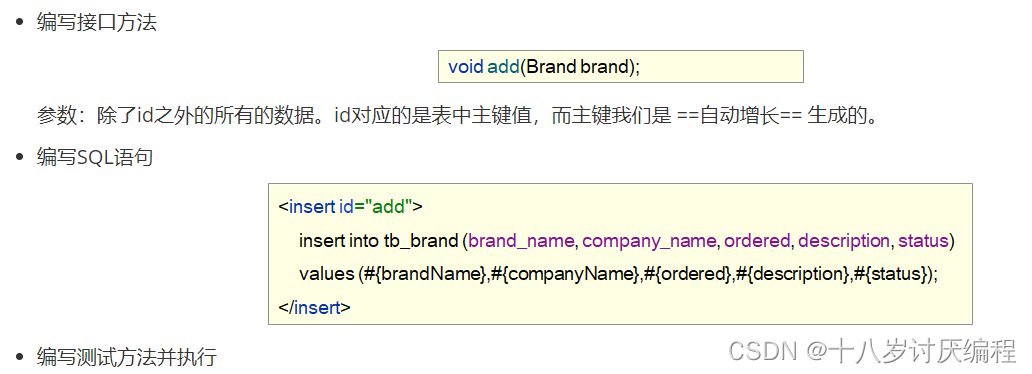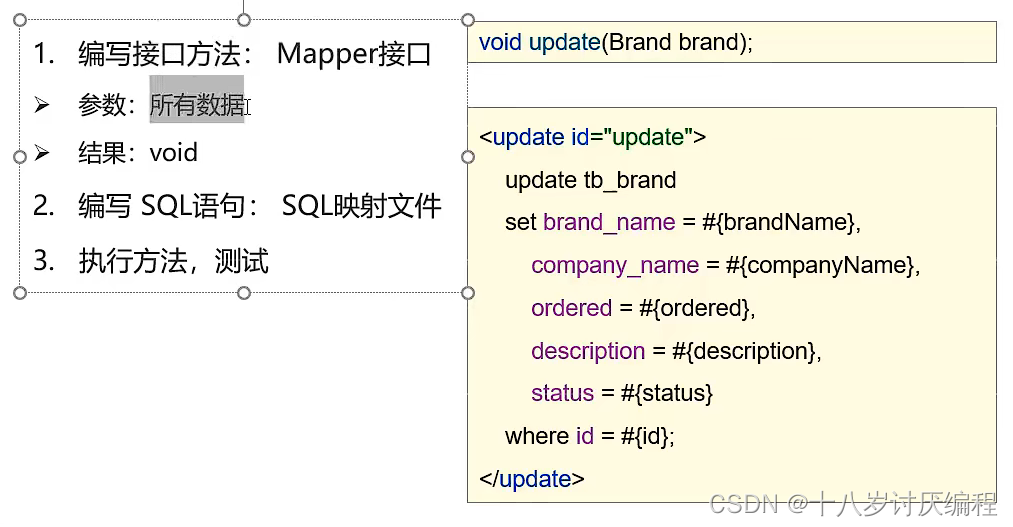MyBatis基础④
配置文件完成增删改查
添加
步骤:

详解:
①编写接口方法
/**
* 添加
*/
void add(Brand brand);
- 1
- 2
- 3
- 4
②编写SQL语句
<insert id="add">
insert into tb_brand (brand_name, company_name, ordered, description, status)
values (#{brandName}, #{companyName}, #{ordered}, #{description}, #{status});
</insert>
- 1
- 2
- 3
- 4
③编写测试方法
public class Try4 {
public static void main(String[] args) throws Exception {
//获取SqlSessionFactory对象
String resource = "mybatis-config.xml"; //此处填写相对于resources的路径
InputStream inputStream = Resources.getResourceAsStream(resource);
SqlSessionFactory sqlSessionFactory = new SqlSessionFactoryBuilder().build(inputStream);
//用SqlSessionFactory对象制造SqlSession对象
SqlSession sqlSession = sqlSessionFactory.openSession();
// //用SqlSession对象来执行sql语句
// List<User> users = sqlSession.selectList("test.selectAll");
BrandMapper mapper = sqlSession.getMapper(BrandMapper.class);
Brand brand = new Brand();
brand.setBrandName("小米");
brand.setCompanyName("小米公司");
brand.setOrdered(50);
brand.setDescription("小米为发烧而生");
brand.setStatus(1);
mapper.add(brand);
sqlSession.commit();
sqlSession.close();
}
}
- 1
- 2
- 3
- 4
- 5
- 6
- 7
- 8
- 9
- 10
- 11
- 12
- 13
- 14
- 15
- 16
- 17
- 18
- 19
- 20
- 21
- 22
- 23
- 24
- 25
- 26
- 27
- 28
- 29
注意:
使用openSession是默认开启事务的,如果不提交事务的话,数据库不会发生变化。在这里有两种解决办法:

主键返回
有时候我们需要返回添加数据的主键
比如:添加订单和订单项
- 添加订单
- 添加订单项,订单项中需要设置所属订单的id
做法:
在 insert 标签上添加如下属性:
- useGeneratedKeys:是够获取自动增长的主键值。true表示获取
- keyProperty :指定将获取到的主键值封装到哪儿个属性里
例如上面的添加的例子中:
<insert id="add" useGeneratedKeys="true" keyProperty="id">
insert into tb_brand (brand_name, company_name, ordered, description, status)
values (#{brandName}, #{companyName}, #{ordered}, #{description}, #{status});
</insert>
- 1
- 2
- 3
- 4
再直接用对象的get方法就可以得到当前的主键值了

修改
修改全部字段

这个方法也可以返回一个int型,表示受影响的行数
①编写接口方法
Integer setAll(Brand brand);
- 1
②编写sql语句
<update id="setAll">
update mybatis.tb_brand set
brand_name = #{brandName},
company_name = #{companyName},
ordered = #{ordered},
description = #{description},
status = #{status}
where id = #{id};
</update>
- 1
- 2
- 3
- 4
- 5
- 6
- 7
- 8
- 9
③执行方法
public static void main(String[] args) throws Exception {
//获取SqlSessionFactory对象
String resource = "mybatis-config.xml"; //此处填写相对于resources的路径
InputStream inputStream = Resources.getResourceAsStream(resource);
SqlSessionFactory sqlSessionFactory = new SqlSessionFactoryBuilder().build(inputStream);
//用SqlSessionFactory对象制造SqlSession对象
SqlSession sqlSession = sqlSessionFactory.openSession();
// //用SqlSession对象来执行sql语句
// List<User> users = sqlSession.selectList("test.selectAll");
BrandMapper mapper = sqlSession.getMapper(BrandMapper.class);
Brand brand = new Brand();
brand.setId(4);
brand.setBrandName("诺基亚");
brand.setCompanyName("诺加亚公司");
brand.setOrdered(50);
brand.setDescription("让每个人都拥有一台手机");
brand.setStatus(1);
mapper.setAll(brand);
sqlSession.commit();
sqlSession.close();
}
- 1
- 2
- 3
- 4
- 5
- 6
- 7
- 8
- 9
- 10
- 11
- 12
- 13
- 14
- 15
- 16
- 17
- 18
- 19
- 20
- 21
- 22
- 23
- 24
- 25
- 26
- 27
- 28
修改动态字段
也就是说我们将来要修改哪个字段是不固定的。那么我们的sql语句就不能写死了。这个时候如果我们仍然按照老办法,那么本不需要修改的那些值会被修改为null。
我们的基本思路就是用if标签去包含每一项。
这个地方我们又会遇到前面遇到过问题,就是如果用户什么都没有修改,那么只有一个set在那里肯定会报错。或者用户修改的其中一项而尾部有一个逗号,那么也会报错。这个时候我们就需要用到MyBatis给我们提供的set标签
set 标签可以用于动态包含需要更新的列,忽略其它不更新的列。
我们可以将sql语句改写为:
<update id="setAll">
update tb_brand
<set>
<if test="brandName != null and brandName != ''">
brand_name = #{brandName},
</if>
<if test="companyName != null and companyName != ''">
company_name = #{companyName},
</if>
<if test="ordered != null">
ordered = #{ordered},
</if>
<if test="description != null and description != ''">
description = #{description},
</if>
<if test="status != null">
status = #{status}
</if>
</set>
where id = #{id};
</update>
- 1
- 2
- 3
- 4
- 5
- 6
- 7
- 8
- 9
- 10
- 11
- 12
- 13
- 14
- 15
- 16
- 17
- 18
- 19
- 20
- 21
删除
删除一个
思路:

①编写接口方法
void deleteOne(int id);
- 1
②编写sql语句
<delete id="deleteOne">
delete from mybatis.tb_brand
where id = #{id};
</delete>
- 1
- 2
- 3
- 4
- 5
③执行方法
public static void main(String[] args) throws Exception {
//获取SqlSessionFactory对象
String resource = "mybatis-config.xml"; //此处填写相对于resources的路径
InputStream inputStream = Resources.getResourceAsStream(resource);
SqlSessionFactory sqlSessionFactory = new SqlSessionFactoryBuilder().build(inputStream);
//用SqlSessionFactory对象制造SqlSession对象
SqlSession sqlSession = sqlSessionFactory.openSession();
// //用SqlSession对象来执行sql语句
// List<User> users = sqlSession.selectList("test.selectAll");
BrandMapper mapper = sqlSession.getMapper(BrandMapper.class);
mapper.deleteOne(1);
sqlSession.commit();
sqlSession.close();
}
- 1
- 2
- 3
- 4
- 5
- 6
- 7
- 8
- 9
- 10
- 11
- 12
- 13
- 14
- 15
- 16
- 17
- 18
- 19
- 20
批量删除
也就是删除多个数据
基本思路:

步骤详解:
①编写接口方法
/**
* 批量删除
*/
void deleteByIds(int[] ids);
- 1
- 2
- 3
- 4
②编写sql语句
批量删除我们不知道要删除几个,所以编写SQL时需要遍历数组来拼接SQL语句。Mybatis 提供了 foreach 标签供我们使用。
foreach 标签
用来迭代任何可迭代的对象(如数组,集合)。
- collection 属性:要遍历的可迭代对象
- mybatis会将数组参数,封装为一个Map集合。
- 默认:array = 数组
- 使用@Param注解改变map集合的默认key的名称
- mybatis会将数组参数,封装为一个Map集合。
- item 属性:本次迭代获取到的元素。
- separator 属性:集合项迭代之间的分隔符。
foreach标签不会错误地添加多余的分隔符。也就是最后一次迭代不会加分隔符。 - open 属性:该属性值是在拼接SQL语句之前拼接的语句,只会拼接一次
- close 属性:该属性值是在拼接SQL语句拼接后拼接的语句,只会拼接一次
<delete id="deleteByIds">
delete from tb_brand where id
in
<foreach collection="array" item="id" separator="," open="(" close=")">
#{id}
</foreach>
;
</delete>
- 1
- 2
- 3
- 4
- 5
- 6
- 7
- 8
假如数组中的id数据是{1,2,3},那么拼接后的sql语句就是:
delete from tb_brand where id in (1,2,3);
- 1
③编写测试方法
@Test
public void testDeleteByIds() throws IOException {
//接收参数
int[] ids = {5,7,8};
//1. 获取SqlSessionFactory
String resource = "mybatis-config.xml";
InputStream inputStream = Resources.getResourceAsStream(resource);
SqlSessionFactory sqlSessionFactory = new SqlSessionFactoryBuilder().build(inputStream);
//2. 获取SqlSession对象
SqlSession sqlSession = sqlSessionFactory.openSession();
//SqlSession sqlSession = sqlSessionFactory.openSession(true);
//3. 获取Mapper接口的代理对象
BrandMapper brandMapper = sqlSession.getMapper(BrandMapper.class);
//4. 执行方法
brandMapper.deleteByIds(ids);
//提交事务
sqlSession.commit();
//5. 释放资源
sqlSession.close();
}
- 1
- 2
- 3
- 4
- 5
- 6
- 7
- 8
- 9
- 10
- 11
- 12
- 13
- 14
- 15
- 16
- 17
- 18
- 19
- 20
- 21
文章来源: blog.csdn.net,作者:十八岁讨厌编程,版权归原作者所有,如需转载,请联系作者。
原文链接:blog.csdn.net/zyb18507175502/article/details/124483343
- 点赞
- 收藏
- 关注作者


评论(0)